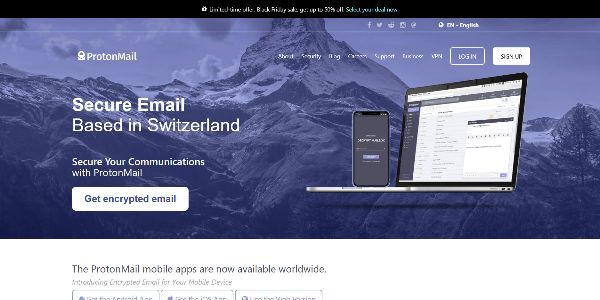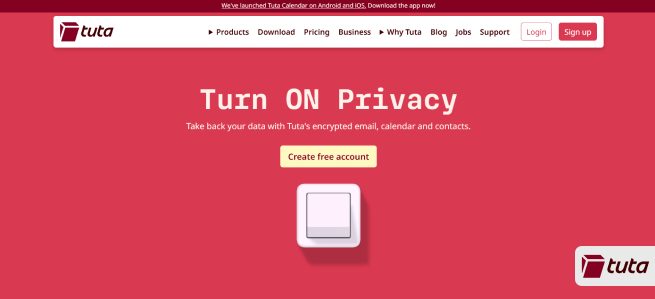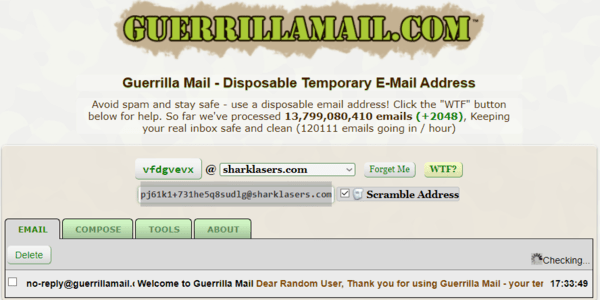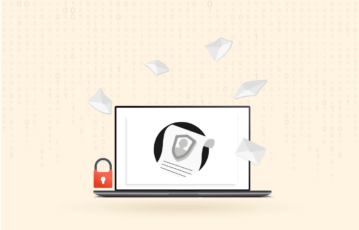Email is still around, and it’s more vital than ever. The new means of communication didn’t kill emails; they just gave it a specific niche for which it’s irreplaceable. Emails are still where our most sensitive information is stored.
But there’s one thing about emails. They’re a two-way identifiable communication system. It’s in the core design and was supposed to be like that from the beginning.
So, how much information are you giving up about yourself when you send an email? Your email address is a prominent piece of data, of course. But that’s not the only thing you should keep in mind. Emails include a lot of information that can identify you in several ways.
But not to worry. Sending anonymous mail is possible; we will show you how in this article.
How to send an anonymous email – The quick guide
Rendering an anon email means suppressing two critical pieces of data: your email address and your IP address. This needs a secure email service. No, you can’t use Gmail, Hotmail, or Yahoo. These services are excellent because of their simplicity, availability, storage capacity, and many other features. But privacy is not their priority, so we’ll need a different provider for this task.
Here’s the simplest way to go:
- First, you need to choose a secure email provider. ProtonMail is today’s best option based on our extensive tests and research.
- Register for ProtonMail (or the service of your choice) and get your mailbox.
- Log in to your private email account.
- There you go! Now you have a new, safer email account.
Quick list of the best anonymous email provider
Here’s a summary of the top private email providers on the market today:
- ProtonMail: It is the most secure mail provider, encrypting each message with PGP encryption and adhering to a strict no-logs policy. Moreover, it has a free plan and reasonably priced subscription plans.
- Tuta: This email provider offers end-to-end encryption for your emails, even when sent outside its network. Because Tuta is an open-source project, it is more transparent than most providers.
- StartMail: StartMail prioritizes its users’ privacy and anonymity, making it the most private email provider on the web. It is a popular Gmail alternative that offers two encryption options, i.e., local encryption and routing via HTTS and PGP.
- Guerilla Mail: A reputable anonymous mail service offering disposable email addresses, allowing you to share emails anonymously. Furthermore, you may use it as a dumpster for undesired spam mail.
What is an anonymous email?
An anonymous email conceals the sender’s identity and includes no personally identifiable information. This means it cannot be tracked back to its source.
It encrypts your messages, making it impossible for anyone to view their content even when intercepted in transit. Moreover, the anon email service masks your IP address, email address, device name, and the time the recipient sends the message.
Why do you need an incognito email?
The words “anonymous mail” may evoke mischievous behavior in your mind. However, some legitimate reasons exist for using anonymized email messages in some scenarios. Here are some of them.
Whistleblowers
Whistleblowers are always Davids fighting against Goliaths. They usually fight for justice against all odds and accept huge risks. The whistleblower can be fighting against crime, corruption, abuse, fraud, sexual harassment, or other violations of the law or human rights. As such, these digital Robin Hoods are usually popular with the public.
But the accused party is usually unhappy about being put in evidence, and they don’t just take it on the chin. So, instead, they fight back, and because they tend to be more powerful than the whistleblower, they can channel massive resources against them, legal or otherwise. Hence, anonymity is a necessity for whistleblowers.
Journalists
Let’s face it. The press isn’t that free worldwide, at least in those places where it’s most needed.
Governments and big corporations do not enjoy exposing their secrets to the public because that makes them weaker, less powerful, or less profitable.
So, journalists working on a big story need to protect their anonymity from communicating back and forth with their sources while they put the story together.
And that’s how anonymity helps investigative journalists keep their work safe while it’s in the process and protects them from reprisals once published.
Read also: Best VPNs for Journalists.
Avoid spam and tracking
Spamming is an industry. There are companies behind it. They go through various websites (like forums and discussion boards) and mailing lists to get every publicly available email address.
Once they have the addresses, they use them in bulk email marketing campaigns. If you don’t want your primary email address included in these annoying operations, an anonymous or disposable email is indispensable when signing up for accounts on suspicious sites.
But besides avoiding spam, there’s another issue. How much do you think Apple, Google, or Facebook know about you? Of course, we all use their services all day because they have much practical value.
But these companies are gathering data on us continually, and they’re either analyzing it for profit or selling it to third parties who know how to monetize it. In this context, untraceable emails are a good measure against Big Tech learning too much about you.
5 ways to send an anonymous email without being tracked
So, you will want to have a private conversation using email. Fine, we can do that! There are several things you can do to meet this goal. However, there’s one thing you should keep in mind. There’s no silver bullet when it comes to this task. The best results will come by using two or more methods concurrently. Adopting one of the following methods will help you secure your email communications.
1. Use an encrypted and anonymous email provider
Encrypted email providers will give you a service that looks just like regular mail on the surface. But your outgoing messages will be encrypted end-to-end to be much safer. The encryption extends to your emails, inbox, and contact list.
Encryption makes your emails look like random, white noise when done at the best level. That prevents any external observer who could intercept them from making sense of them. So neither your ISP nor the government, and in some cases, even your email provider, will be able to read your messages.
There are several secret email accounts on the web. Each offers a slightly different service with an emphasis on some features. These are the best ones available today:
- ProtonMail. It emphasizes security over anonymity, and it’s the best in this regard
- Tuta. This one is all about anonymity
- StartMail. The easiest one to use
- Guerilla Mail. Provides temporary emails so that you can avoid spam
2. Use a burner email account
If you’ve seen TV shows like “The Wire” or “Breaking Bad.” The “heroes” on these shows buy the cheapest phones, have them in prepaid plans, use them, and then get rid of them. That way, they get all the advantages of mobile communications without leaving a trail that leads back to them. Burner emails are precisely like that.
These anonymous email accounts expire after a fixed period, or that will allow you to send an email without registering for an account. In either case, your message can’t be traced back to you. Another option is the AnonymouseMail, which lets you send an utterly anonymized message to any receiver (but this option is send-only; you won’t be able to get an answer).
Burner emails are helpful to keep spam away from your real accounts when you need to register to fishy websites. However, any account you register using a burner email will be tricky to manage, especially if you need to reset a password using a link because those are usually sent to the registered email – which won’t exist anymore by then. So, decide wisely and use burner emails for accounts you know won’t be that important in the long run.
3. Hide your IP
You can encrypt a message; nobody can read its contents but the person on the other end with the decryption key. However, that email will still carry your IP address data, which could be a severe liability as your email address or external interception. So what can you do?
You can hide your IP address using three services: a proxy server, a virtual private network (VPN), or a Tor browser. Each option has advantages and disadvantages.
VPNs will route all your traffic (previously encrypted) through one of the servers in their network. The server will tell the world that your IP address is it is own or one the network assigns.
In most good VPNs, you can choose the country you want your IP to come from. However, if you want your VPN to be safe, you must choose one that adheres strictly to a no-logs policy – which means you have to pay for it; free VPNs keep logs of all your activities and sell them for profit.
The Tor browser is a network that relays web traffic through several nodes in a system maintained by volunteers. While exceedingly slow, Tor connections and originating IP addresses are humanly impossible to trace back to their starting point.
If you are the really paranoid type of geek, you’ll be happy to know that a quality VPN like NordVPN will allow you to use both technologies (VPN and Tor) simultaneously. This high level of IP masking and encryption is probably unnecessary given the current state of the art, but it’s still good to know it’s available.
Last but not least, you have the proxy server option. These servers will report your IP address as theirs, which is like a VPN. Except that proxies do not provide encryption. Like in the VPN case, it’s essential to ensure that your service provider doesn’t keep any logs; otherwise, you’re not avoiding security and anonymity problems, just sweeping them under the rug.
4. Get rid of the metadata
OK, now you have a ProtonMail account that you only use through your new NordVPN account with a Tor browser. If the “anonymous” email you’re sending includes a document with metadata including your name, phone number, address, and other vital stats, what was the point of all those precautions?
If you include an attachment, especially an image, you must ensure you’ve stripped it bare of any EXIF data.
Windows users will be happy to know that “Document Inspector” removes all the metadata from a given document.
5. Sign up for a new email account
Simple solutions can be as effective as sophisticated ones. So, you can always sign up for a new email account with Yahoo, Google, or Microsoft without worrying about encryption. Instead, you can provide a false name, home address, and date of birth, skip the phone number (though that’s becoming increasingly harder), and send the anonymous mail you want.
The emails you send from this fake account will be anonymous insofar as your real name is concerned, but don’t forget the following things: your actual IP address will be in each message; also, don’t expect Google or Yahoo to treat you any differently just because you gave them fake data. They will still monitor your activities and provide the account’s information to law enforcement if required.
What is spoofed mail?
A question is probably on your mind now: why can’t you send an email without a sender address? The answer is that the protocol requires one. It is not a helpful trick because, if you try it, you will get errors from the system, some servers will reject it, and the message will cause suspicions. However, there’s another way of doing things, and it’s called “spoofing.”
Spoofing is using a false sender address when you send an email. Spoofing is not too hard to do because SMTP (Simple Mail Transfer Protocol) doesn’t check the information in fields such as “From,” “Reply to,” or “Sender.” Also, the email address is not that important when trying to track back an email address. The IP address, on the other hand, is crucial. In other words, spoofed emails can still be traced if they include an accurate IP address.
So, how can you perform the whole trick of sending an untraceable spoofed email? By using a VPN. A VPN will mask your IP address and assign you a new one from its network. Another option is to use a compromised server to send the email in question, but this option is more on the black-hat side of things, preferred by digital criminals or those who run malicious email campaigns, so we do not suggest you use it.
Anonymous email: The top providers
As stated earlier, having an encrypted email provider is crucial to secure email communications. Here are the best ones in the industry:
1. ProtonMail

- Website URL: proton.me
ProtonMail is the best secure mail provider in the world. Period. Every message gets PGP encryption before it leaves your device. In addition, the parent company espouses a strict no-log policy.
No-log policies are crucial in VPN and secure email providers. So how come, we hear you ask? First, every company has to have a headquarters somewhere. Second, suppose that somewhere is one of the world’s jurisdictions where a corporation must share client activity data with the government.
In that case, the corporation will do it because it’s its legal obligation. That means your data goes to the government if it asks for it. So, the only way to ensure that the company can fulfill its legal obligation without betraying your privacy and anonymity is for them to keep no records of your activity.
If it deletes your user data every time you finish a session, it will have nothing to share with the government about you. And that is why zero-log policies are crucial.
But let’s go back to ProtonMail.
It offers a free plan and several monthly paid subscriptions (starting at 4 USD). The fee gives you more secure messages per day. However, the most privacy-savvy won’t be too happy to learn that your account needs a phone number for confirmation.
Mission Impossible fans will also appreciate the self-destructing message feature of ProtonMail. Once a message is ready, you set an expiration time, and ProtonMail will do away with the messages.
Additional perks include free VPN service apps for Android and IOS and an encrypted calendar.
2. Tuta

- Website URL: tuta.com
Tuta supports end-to-end encryption for your emails. You can even send encrypted emails to users outside the Tuta network if necessary. The encryption shuffles the info in your contacts as well as your inbox.
Some readers will be happy to know that signing up for a new account at Tuta requires no identifiable personal information whatsoever. This provider deletes your IP address from every email you send (one of the critical and most challenging things to achieve in anonymizing emails).
Tuta is an open-source project. So everybody can download and read the code, audit it, and try it. This adds a degree of transparency that you seldom get with any email provider of any kind.
Tuta has a service for every budget – even no budget at all. The free service gives you 1GB of storage, which is plenty if you’re not keen on attachments, but it has other limitations: your storage is good for four weeks only. On the other hand, if you want an encrypted calendar and complete email history, you can pay a subscription as cheap as 1.20 EUR monthly.
3. StartMail

- Website URL: startmail.com
Imagine how Gmail could be if it cared about your privacy instead of finding new ways to deliver ads. That’s StartMail, a widely-used Gmail alternative. Its parent company also owns and operates StartPage, one of those rare search engines designed with privacy in mind.
Since privacy and anonymity are a priority in the company’s mission, StartMail offers one of the most private email services on the Internet. It supports burner emails, for instance, so that you can protect your mailbox with a virtual barrier.
There are two encryption options in StartMail. The standard option is to encrypt your message locally, then send it through HTTS. But it also supports PGP, which is a more popular option among the most enthusiastic encryption users. PGP, of course, requires that both the sender and the receiver exchange their public encryption keys in advance. Otherwise, one of the parties won’t be able to recover the message’s plain text.
4. Guerilla Mail

- Website URL: guerrillamail.com
Guerrilla Mail is a top-rated incognito email provider that’s been around since 2006.
It’s a different service from the others. It provides you with a disposable email address that allows you to send and receive emails anonymously. You can create the email address yourself or just let Guerrilla do it in your stead if you don’t have the time or the inclination to work out the details. You can even send emails without an account, making things more accessible.
A Guerrilla Mail address is helpful when you want to open up a new account for a possibly fishy site where you don’t wish to provide your email address. A nice byproduct is that you can use your Guerilla email account as a dumpster for unwanted spam emails that are the bane of online life or use when you do not trust a sender.
And it’s free! Guerilla has dealt with over 13 billion emails; the service is still running! The number of Guerilla users keeps growing steadily; you could be the next one!
Factors to consider when choosing an anonymous email provider
Before selecting an untraceable email provider, there are various factors you should consider.
- Does the provider offer a built-in encryption feature? – Encryption features are paramount to protecting your sensitive information from intruders. An ideal secret email provider should have encryption as an extra layer of protection.
- The purpose of the unidentified email – It would help if you also considered the intended purpose of the service. You can identify the features you’ll need most by considering how you plan on using the service. For instance, you should ask yourself if the service is meant to send emails only or both receiving and sending, limit the number of users, and security functions, among others.
- Can you configure Internet Message Access Protocol (IMAP) using the service? – To track messages sent in incognito mode, you must connect with mail to IMAP. The feature saves your messages on your Internet Provider Server, enabling you to access your messages on any device.
- Which privacy features are present on the provider? – Identifying the various privacy features, such as two-step verification and no-ads, is essential when choosing an anony email provider. While some providers claim that they protect users fully, it’s been found that some collect information in the form of ads. This means the provider shares your data with third parties, compromising anonymity. Therefore, features such as 2FA are crucial in improving your security and privacy.
Email services to avoid
Big corporate email companies like Gmail and Yahoo are free, easy to use, and offer native apps. However, they do not focus on user privacy and can even access your email accounts. So, if you value your privacy, avoid the following email providers:
- Yahoo Mail: In 2016, it was discovered that Yahoo provided U.S. intelligence officers backdoor access to hundreds of millions of user accounts. Moreover, Yahoo joined Verizon Media in 2017, a corporation that acknowledged using device IDs, cookies, and other ways to monitor users.
- Gmail: Google has a history of dubious practices, such as examining email content for ‘marketing purposes.’ Although it claims to have ceased this behavior in 2017, it still confesses to offering third parties access to user inboxes.
- AOL Mail: This email service is still functional and was incorporated into Verizon Media in 2017. As a result, it will record personally identifiable information such as cookie details and IP addresses to monitor users’ online activities.
Security and anonymity in email do matter
The usual big tech email providers do indeed offer excellent services. But privacy is not at the heart of their missions, and they even use your activities to target the ads they send your way – they pay their bills by selling advertising. They need to analyze your browsing habits and email content to decide which ads will work better for you. As a result, your privacy is not in the safest hands with those providers.
Additionally, the emails sent through the standard providers include the usual meta-data that goes out with every regular email. That includes your IP address, and anybody willing to read the whole header in the mail can find it out. So, how bad is that data leak? A competent hacker can determine your physical location using your IP address up to your city, state, ZIP code, ISP, and even more details.
Conclusion
The digital world has changed rapidly since the Internet transcended the academic world to become available to everybody. The email was the killer app that showed why everybody should have Internet access when that process started.
Things have changed since then. First, smartphones appeared and changed the game. Telegram, WhatsApp, Line, and other messengers now provide communication services that are cheaper and faster than email. Even over the last couple of years, in which the pandemic has pushed Zoom and other video conferencing tools to the surface, email remains a crucial tool that none of the new technologies can replace.
And precisely because email is so valuable and essential, there are circumstances in which having an anonymous email service is not only helpful but vital.
Spoofed emails can help protect your integrity and security if your work involves high risks. But even if you’re a regular user, untraceable emails and similar services can still help you protect your primary email address so that unwanted messages don’t become polluted. Or simply so that it remains private enough that only the people you need to know it can use it, as it was in the beginning.
Fortunately, good incognito email services guarantee your privacy, anonymity, and safety when needed. Moreover, they’re fast, cheap, and reliable, so there’s no excuse to avoid them if a situation calls for them.
We hope the information in this article will help you enhance your digital life by staying safe when it matters, thus increasing your peace of mind.
FAQs
It depends. If you send an email through Gmail’s web service, your IP address and hostname won’t leak. On the other hand, if you’re using Gmail as your email server in an email client such as Outlook or Thunderbird, then your IP address and hostname will be included in the message’s header. But the information in the last paragraph is relevant in ordinary circumstances only. So, for example, if Gmail must reveal your IP address during a legal process, it will disclose it to the authorities, even if the message itself didn’t carry it.
You can’t. The address in the “From” field is mandatory per the protocol rules, and you can’t leave it empty. What you can do, instead, is to use a false email address so that the receiver thinks it comes from somebody else. This trick is called “spoofing.” But do not forget that the domain in the fake address must be authentic; otherwise, spam filters will filter it.
No, you can’t. Outlook always associates an email account with a user or a sender. It’s built-in, and you can’t bypass it. If the address in the “From” field doesn’t match the address associated with the Outlook user, you’ll get an error, and the message won’t leave your computer.
No, it’s not. Gmail observes your emails and online activity closely because that’s how it chooses the advertising it will serve you. In this regard, anonymity works against Google’s business model, so you shouldn’t expect it. You can always have a Gmail account with false personal information. If, in addition, you always use a VPN to use that account, then your privacy will be as safe as it can be in Gmail.
By using a Tor or a VPN when sending the email in question. Both services will substitute your IP address with another one from the network. This will allow you to hide your IP address successfully.
A burner email account is a fully functional email account that is disposable. You can use it as many times as you’d like for any purpose you’d like. Then, when you’re done with it, you can dispose of it. Of course, it would be best if you didn’t keep any critical contacts on account of this type, and it ideally won’t be linked to your real name or other important accounts.
Google’s privacy policy is somewhat transparent, while Microsoft’s security settings are a mystery wrapped in a riddle wrapped in an enigma. Google’s authentication options are far more advanced than Outlook’s (2FA is available), and it has other bonus features, such as a separate junk folder. Gmail is better than Outlook where security is concerned.




